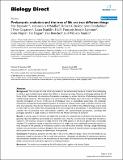Prokaryotic evolution and the tree of life are two different things
Author(s)
Martin, William; Dagan, Tal; Dupre, John; Lapointe, François-Joseph; Franklin-Hall, Laura; Gogarten, J. Peter; Ereshefsky, Marc; Beiko, Robert G.; O'Malley, Maureen A.; Bapteste, Eric; Boucher, Yan; ... Show more Show less
DownloadBapteste-2009-Prokaryotic evolutio.pdf (403.3Kb)
PUBLISHER_CC
Publisher with Creative Commons License
Creative Commons Attribution
Terms of use
Metadata
Show full item recordAbstract
Background: The concept of a tree of life is prevalent in the evolutionary literature. It stems from attempting to obtain a grand unified natural system that reflects a recurrent process of species and lineage splittings for all forms of life. Traditionally, the discipline of systematics operates in a similar hierarchy of bifurcating (sometimes multifurcating) categories. The assumption of a universal tree of life hinges upon the process of evolution being tree-like throughout all forms of life and all of biological time. In multicellular eukaryotes, the molecular mechanisms and species-level population genetics of variation do indeed mainly cause a tree-like structure over time. In prokaryotes, they do not. Prokaryotic evolution and the tree of life are two different things, and we need to treat them as such, rather than extrapolating from macroscopic life to prokaryotes. In the following we will consider this circumstance from philosophical, scientific, and epistemological perspectives, surmising that phylogeny opted for a single model as a holdover from the Modern Synthesis of evolution.
Results: It was far easier to envision and defend the concept of a universal tree of life before we had data from genomes. But the belief that prokaryotes are related by such a tree has now become stronger than the data to support it. The monistic concept of a single universal tree of life appears, in the face of genome data, increasingly obsolete. This traditional model to describe evolution is no longer the most scientifically productive position to hold, because of the plurality of evolutionary patterns and mechanisms involved. Forcing a single bifurcating scheme onto prokaryotic evolution disregards the non-tree-like nature of natural variation among prokaryotes and accounts for only a minority of observations from genomes.
Conclusion: Prokaryotic evolution and the tree of life are two different things. Hence we will briefly set out alternative models to the tree of life to study their evolution. Ultimately, the plurality of evolutionary patterns and mechanisms involved, such as the discontinuity of the process of evolution across the prokaryote-eukaryote divide, summons forth a pluralistic approach to studying evolution.
Reviewers: This article was reviewed by Ford Doolittle, John Logsdon and Nicolas Galtier.
Date issued
2009-09Department
Massachusetts Institute of Technology. Department of Civil and Environmental EngineeringJournal
Biology Direct
Publisher
BioMed Central
Citation
Bapteste, Eric et al. “Prokaryotic evolution and the tree of life are two different things.” Biology Direct 4.1 (2009): 34.
Version: Final published version
ISSN
1745-6150